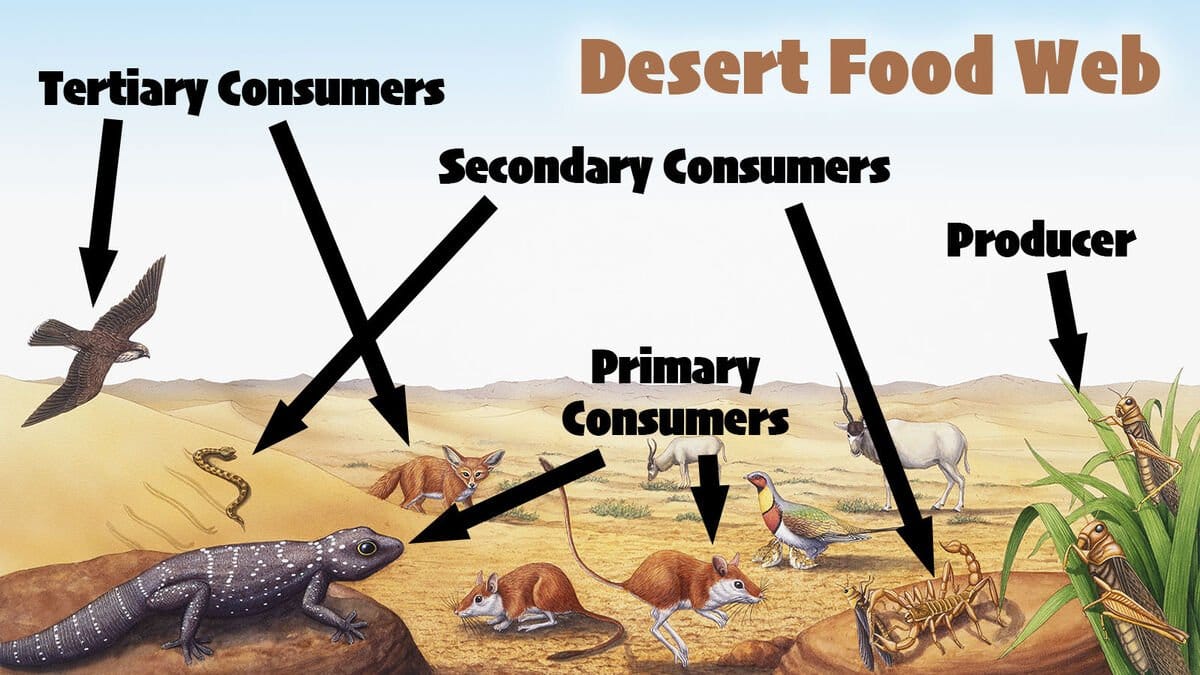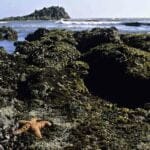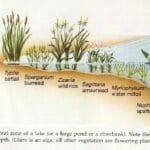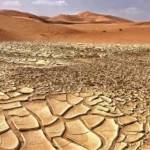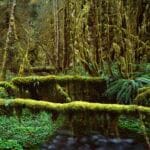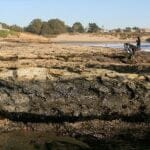Imagine a world where life thrives in a sea of sand and scorching heat. Welcome to the captivating and enigmatic world of the desert. Join us as we delve into the hidden threads that connect the creatures that call this harsh environment home. From tiny ants to soaring desert bighorn sheep, each plays a crucial role in the intricate tapestry of the desert’s food web. Let’s unravel the secrets that keep this unforgiving ecosystem in perfect balance.
Food Web for the Desert
Picture a desert: scorching sun, sand stretching as far as the eye can see, and… a surprising amount of life! It’s harsher than a picnic in the park, but plants and animals still manage to thrive in this challenging environment. The secret? A delicate balance of who eats who, known as a food web.
Think of it like a chain reaction, with energy passing from one living thing to the next. At the bottom of this chain, we find the desert’s tough guys: plants like cacti. They’re the real MVPs, making their own food from sunlight through photosynthesis and anchoring the entire desert ecosystem. These plants are called producers.
But cacti aren’t just sunbathers, they’re also dinner! Desert herbivores, like insects and kangaroo rats, have evolved amazing adaptations to munch on these prickly plants. Some have specialized teeth for gnawing, while others can extract moisture from the plants, making the most of every bite. These herbivores are called primary consumers.
These herbivores, in turn, become tasty snacks for the next level up: the carnivores, or secondary consumers. Coyotes, snakes, and birds of prey are just a few of the skilled hunters who rely on these desert dwellers for their meals. They’ve developed incredible speed, camouflage, and hunting strategies to survive in this challenging landscape. At the top of the food chain are the tertiary consumers, or apex predators. These animals, like bobcats, hawks, and certain snakes, have few natural predators and help keep the populations of other animals in check.
But the story doesn’t end there! Even the waste and remains of plants and animals become part of the food web. Decomposers, like bacteria and fungi, break down this organic material, releasing nutrients back into the soil. These nutrients then help support the growth of… you guessed it, more plants, starting the cycle all over again. Uncover the intricacies of the desert ecosystem and delve into the fascinating roles played by decomposers in the desert and desert producers. Explore how these organisms interact and contribute to the delicate balance of life in this arid environment.
Studying the desert food web is like piecing together a complex puzzle. It reveals the fascinating ways that life persists in even the harshest environments. Scientists are still uncovering the intricate details of these ecosystems, and ongoing research constantly reveals new relationships and adaptations.
One thing is certain: the desert food web highlights the interconnectedness of all living things. Disrupting this delicate balance, for example, through habitat loss or climate change, can have ripple effects throughout the entire system. Protecting these fragile ecosystems is crucial for ensuring the survival of the amazing array of life that calls the desert home.
What is the food web in the desert?
We’ve already talked about how harsh and unforgiving deserts can be, but even amongst the sand and scorching sun, life finds a way to thrive. It’s not just about individual species toughing it out, though. It’s about how they all fit together in a delicate dance of survival – a complex network we call the food web.
Think of it like a chain reaction, but instead of splitting atoms, it’s all about who eats who! This intricate web of life is how energy and nutrients get passed around in the desert. From the tiniest ant to the slyest coyote, every creature plays a vital role. If one piece goes missing, the whole system can get thrown out of whack.
Desert food webs are fascinating because they demonstrate the remarkable adaptations that organisms have developed to cope with the challenges of limited resources.
Plants: Desert plants have evolved an array of adaptations to survive in this arid environment. Some, like cacti, have developed thick, fleshy stems to store water, while others have deep roots to tap into underground water sources. Some plants have even evolved to have small leaves or spines to minimize water loss through transpiration.
Animals: Animals also exhibit a variety of adaptations to survive in the desert. Many are nocturnal, avoiding the heat of the day by being active at night. Some, like kangaroo rats, get most of their water from the food they eat, while others have evolved efficient kidneys to conserve water.
Sadly, these incredible adaptations may not be enough to protect desert ecosystems forever. Human activities and the impacts of climate change are putting a real strain on these delicate balances. Pollution, habitat loss, and the introduction of invasive species all threaten to disrupt the intricate connections within the food web.
That’s why understanding the desert food web is so important. The more we learn about how these ecosystems function, the better equipped we’ll be to protect them. It’s up to us to ensure that these fascinating and fragile environments continue to thrive for generations to come.
What food is in the desert?
So, we’ve talked about the challenges of living in a place where water is scarce and the sun beats down relentlessly. But what about the food situation? You might be surprised to learn that even in the seemingly barren desert, there’s actually a whole lot to eat – if you know where to look, of course!
Think of the desert as a giant puzzle, where each living thing plays a crucial role. At the bottom of this puzzle are the plants – the real heroes of the desert. These aren’t your average backyard flowers, though. We’re talking about tough survivors like cacti, those prickly wonders that have mastered the art of hoarding water. Their thick stems are like built-in reservoirs, allowing them to weather long periods of drought. Then there are the shrubs and grasses, which have developed their own clever tricks for hanging onto moisture. Some have teeny-tiny leaves to minimize water loss, while others send their roots deep into the ground, searching for hidden sources of water.
These resilient plants provide the fuel for the next level of our desert puzzle: the herbivores. This group includes all sorts of critters that have adapted to a plant-based diet in a land where greenery can be hard to come by. You’ve got your insects, busily munching on leaves and seeds. Then there are the rodents, like kangaroo rats and desert mice, who’ve evolved to get most of their water from the food they eat. And don’t forget the reptiles! Tortoises, for example, are experts at grazing on desert vegetation, storing up nutrients to help them survive.
But what about the meat-eaters? Don’t worry, the desert has those too! We’re talking about the carnivores – the hunters of the desert. These guys rely on the herbivores for their meals, keeping the whole ecosystem in balance. You’ve got your snakes, some venomous, some not, slithering through the sand in search of a tasty rodent or lizard. Then there are the birds of prey, like hawks and owls, soaring high above the desert floor, their sharp eyes scanning for movement. And of course, no desert would be complete without its iconic mammals! Coyotes, foxes, and even bobcats – these cunning predators play a vital role in keeping herbivore populations in check, ensuring that there’s enough food to go around.
One fascinating thing about desert food webs is how interconnected everything is. Take the relationship between the desert tortoise and the prickly pear cactus, for example. The tortoise relies on the cactus for both food and water, especially during the driest months. But the cactus also benefits from this relationship! When the tortoise eats the cactus fruit, it helps to disperse the seeds, allowing new cactuses to grow. It’s these kinds of intricate relationships that make the desert ecosystem so fascinating – and so resilient.
Scientists are still unraveling all the mysteries of desert food webs, and new discoveries are being made all the time. For example, recent research suggests that some desert animals might be more flexible in their diets than previously thought, switching between plants and insects depending on what’s available. These adaptations highlight the remarkable ability of life to find a way, even in the harshest of environments.
So, the next time you find yourself picturing a desert, don’t just imagine a desolate wasteland. Instead, imagine a vibrant tapestry of life, woven together by the threads of a complex and fascinating food web.
What are 10 Consumers in the Desert?
So, we’ve talked about how the desert, despite its harsh conditions, is actually teeming with life. And a big part of that life is made up of “consumers” – creatures that, unlike plants, can’t make their own food and have to eat other living things to survive. Let’s meet some of these desert dwellers and see what’s on their menu!
First up, the plant eaters, or as scientists call them, the “primary consumers”:
- Kangaroo Rats: Picture a mouse on a mission – that’s a kangaroo rat zipping through the undergrowth. These guys are all about seeds, fruits, and juicy leaves, hopping around on their strong back legs to find their next meal.
- Cactus Mice: Don’t let the name fool you, these little guys are tough! They’ve figured out how to handle the prickly, dry desert and can often be found nibbling on (you guessed it) cactus pads and fruits.
- Lizards: Sunbathing on rocks is just a side hustle for lizards. Their real job? Being incredible bug hunters! Ants, beetles, you name it – if it’s small and crawling around, a lizard probably thinks it’s delicious.
- Poorwills: These birds are the opposite of early birds – they’re all about that night life. With their big eyes and amazing hearing, they stealthily snatch up insects in the dark.
- Desert Tortoises: Slow and steady wins the race, or at least finds enough to eat! These gentle giants munch their way through the desert, enjoying a varied diet of plants, from cacti and flowers to grasses.
Now, let’s move on up the food chain to the meat-eaters and those who enjoy a mixed diet, the “secondary consumers”:
- Kit Foxes: These adorable little foxes are masters of disguise and stealth. They use their sharp senses to hunt down rodents, lizards, and even the occasional unlucky insect.
- Elf Owls: Don’t be fooled by their size, these tiny owls are fierce predators! They perch quietly and wait for the perfect moment to swoop down and grab rodents and insects with their sharp talons.
- Red-Tailed Hawks: Soaring high above the desert, these hawks have a bird’s-eye view (literally!) of their hunting grounds. They’re always on the lookout for reptiles, small mammals, and even other birds to snatch up.
- Scorpions: Okay, we’re getting into “don’t touch” territory here. Scorpions use their venomous stingers to subdue their prey, which includes insects, spiders, and small lizards. It’s a harsh reminder that even in the desert, it’s eat or be eaten.
- Rattlesnakes: Slithering through the sand, these venomous snakes are the stuff of desert legend (and nightmares!). They lie in wait, hoping to ambush a rodent, rabbit, or bird for their next meal.
A Few Things to Keep in Mind
This is just a small glimpse into the world of desert consumers. Keep in mind:
- It’s all connected: What one animal eats affects the other creatures around it. It’s like a giant puzzle where every piece matters.
- Things are always changing: Scientists are constantly learning more about deserts and how they work. New species are discovered, and we gain a better understanding of how these ecosystems function.
- We have an impact: Human activities like climate change and habitat destruction can significantly affect desert life. It’s our responsibility to learn about and protect these amazing ecosystems.
So, next time you think about the desert, don’t just picture sand dunes – imagine the bustling world of creatures, big and small, that call it home and the delicate balance they maintain.
What is the Answer to the Desert Biome Food Web?
The “answer” to the desert biome food web isn’t a simple one-liner. It’s about understanding the intricate connections and adaptations that allow life to thrive in such an extreme environment. Here’s a breakdown:
- It’s a delicate balance: The desert food web is a complex system where each organism plays a crucial role. Disruptions to one part of the web, such as the loss of a predator or a decrease in plant life, can have ripple effects throughout the entire ecosystem.
- Adaptation is key: Desert organisms, from plants to animals, have evolved remarkable adaptations to survive in a world of scarce water and extreme temperatures. Understanding these adaptations is key to appreciating the resilience of desert life.
- We have a role to play: Human activities can have a significant impact on desert ecosystems. It’s our responsibility to learn about these fragile environments and to support conservation efforts that protect their biodiversity.
So, the answer to the desert biome food web lies in appreciating its complexity, understanding its delicate balance, and recognizing our responsibility to protect it.
- Amazing March Fun Facts: Unveiling History & Celebrations - April 15, 2025
- Master how to write height: A complete guide - April 15, 2025
- How High Are Your Standards Test: Find Your Perfect Match Now - April 15, 2025
